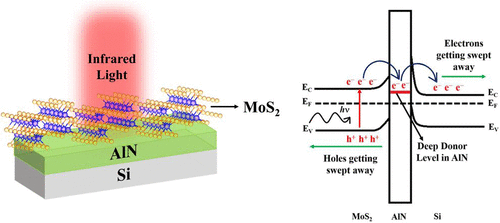当前位置:
X-MOL 学术
›
ACS Appl. Electron. Mater.
›
论文详情
Our official English website, www.x-mol.net, welcomes your
feedback! (Note: you will need to create a separate account there.)
Defect-Mediated Transport in Self-Powered, Broadband, and Ultrafast Photoresponse of a MoS2/AlN/Si-Based Photodetector
ACS Applied Electronic Materials ( IF 4.3 ) Pub Date : 2020-03-19 , DOI: 10.1021/acsaelm.0c00007 Deependra Kumar Singh 1 , Rohit Pant 1 , Arun Malla Chowdhury 1 , Basanta Roul 1, 2 , Karuna Kar Nanda 1 , Saluru Baba Krupanidhi 1
ACS Applied Electronic Materials ( IF 4.3 ) Pub Date : 2020-03-19 , DOI: 10.1021/acsaelm.0c00007 Deependra Kumar Singh 1 , Rohit Pant 1 , Arun Malla Chowdhury 1 , Basanta Roul 1, 2 , Karuna Kar Nanda 1 , Saluru Baba Krupanidhi 1
Affiliation

|
By combining unique properties of ultrathin 2D materials with conventional 3D semiconductors, devices with enhanced functionalities can be realized. Here, we report a self-powered and ultrafast photodetector based on a hybrid MoS2/AlN/Si heterostructure. The heterojunction is formed by depositing a MoS2 thin film by pulsed laser deposition on an AlN/Si(111) template. The vertical transport properties of the device under dark and light illumination conditions exhibit an excellent photoresponse in a broad range of wavelengths (300–1100 nm) at 0 V. The maximum responsivity of this photodetector is found to be 9.93 A/W at a wavelength of 900 nm. The device shows an ultrafast temporal response with response/recovery times of 12.5/14.9 μs. X-ray photoelectron spectroscopy and cross-sectional transmission electron microscopy reveal the presence of native oxygen impurities in AlN throughout the bulk of the film. These oxygen defects form a deep donor level in AlN and play a crucial role in the transport of the photogenerated carriers, resulting in enhanced device performance.
中文翻译:

MoS 2 / AlN / Si基光电探测器在自供电,宽带和超快速光响应中的缺陷介导传输。
通过将超薄2D材料的独特特性与常规3D半导体相结合,可以实现功能增强的设备。在这里,我们报告基于混合MoS 2 / AlN / Si异质结构的自供电超快光电探测器。通过沉积MoS 2形成异质结脉冲激光沉积在AlN / Si(111)模板上形成薄膜。在黑暗和明亮的照明条件下,该器件的垂直传输特性在0 V的宽波长范围(300–1100 nm)中均表现出出色的光响应。发现该光探测器的最大响应度在波长为9.93 A / W 900 nm。该设备显示了超快速的时间响应,响应/恢复时间为12.5 / 14.9μs。X射线光电子能谱和横截面透射电子显微镜揭示了整个薄膜中AlN中天然氧杂质的存在。这些氧缺陷在AlN中形成深的供体水平,并在光生载流子的传输中起关键作用,从而提高了器件的性能。
更新日期:2020-03-19
中文翻译:

MoS 2 / AlN / Si基光电探测器在自供电,宽带和超快速光响应中的缺陷介导传输。
通过将超薄2D材料的独特特性与常规3D半导体相结合,可以实现功能增强的设备。在这里,我们报告基于混合MoS 2 / AlN / Si异质结构的自供电超快光电探测器。通过沉积MoS 2形成异质结脉冲激光沉积在AlN / Si(111)模板上形成薄膜。在黑暗和明亮的照明条件下,该器件的垂直传输特性在0 V的宽波长范围(300–1100 nm)中均表现出出色的光响应。发现该光探测器的最大响应度在波长为9.93 A / W 900 nm。该设备显示了超快速的时间响应,响应/恢复时间为12.5 / 14.9μs。X射线光电子能谱和横截面透射电子显微镜揭示了整个薄膜中AlN中天然氧杂质的存在。这些氧缺陷在AlN中形成深的供体水平,并在光生载流子的传输中起关键作用,从而提高了器件的性能。











































 京公网安备 11010802027423号
京公网安备 11010802027423号